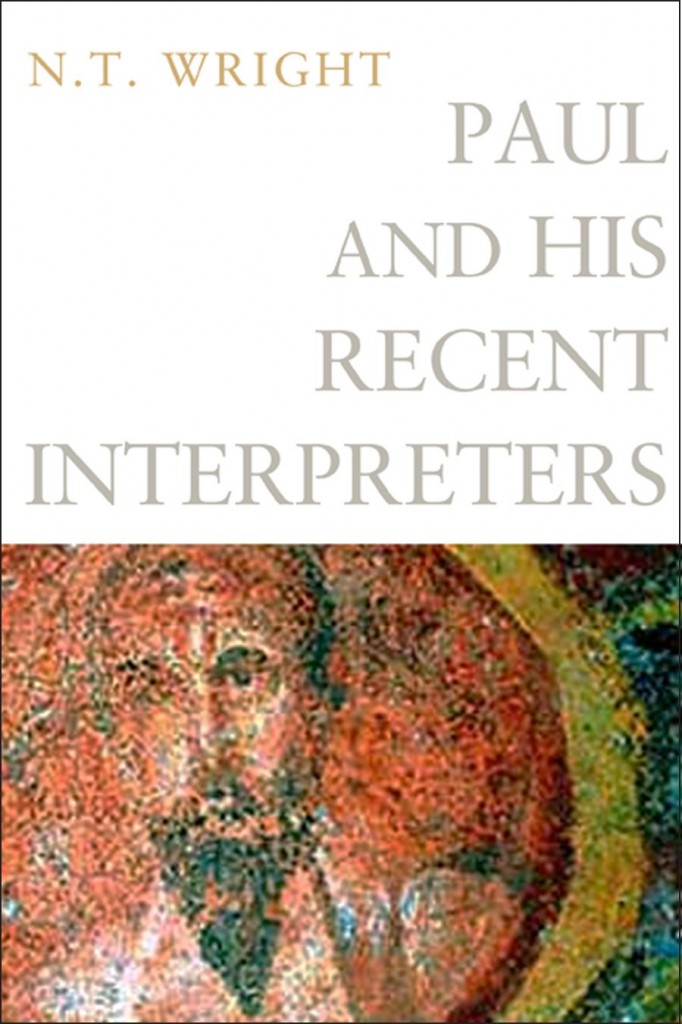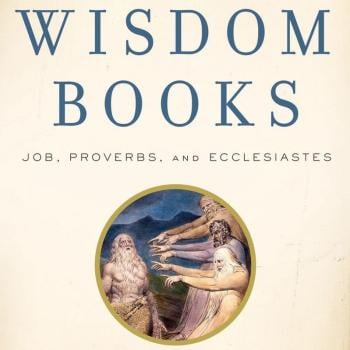When one turns the page to Chapter Ten and the third major section of Tom’s book, the atmosphere changes. This is in part because Tom is very affirming of the recent gains in studying Paul in light of the social history of Paul’s period. He finds himself much indebted to Edwin Judge and his work in this regard, and also quite congenial with many of the insights of Wayne Meeks. It may come as something of a surprise that Tom thinks Meek’s First Urban Christians is in some ways the most important and fresh light on Paul that we have had over the past half century. I say ‘surprise’ because you wouldn’t necessarily be able to deduce this perspective simply by reading Tom’s own commentaries (which are highly theological and narratological in character) or even much of his recent Paul and the Faithfulness of God.
Wright reviews some of the major contributors to the social history and social sciences discussion of the NT beginning with E.A. Judge and his 1960 little study on the Earliest Christians… and quotes him approvingly as follows…… “It may be asserted that ideas are never satisfactorily explained merely by discovering their philosophical connections. They must be pinned down in relation to the particular circumstances in which they were expressed. The meaning is fixed at this point, and cannot be certainly ascertained until it is identified… It may be asserted that ideas are never satisfactorily explained merely by discovering their philosophical connections. They must be pinned down in relation to the particular circumstances in which they were expressed. The meaning is fixed at this point, and cannot be certainly ascertained until it is identified.” From The
Social Pattern of Christian Groups in the First Century pp. 8-9 [see reprint in D.M. Scholer].
Here’s another citation from Judge with which Tom agrees….”Far from being a socially depressed group, then, if the Corinthians are at all typical, the Christians were dominated by a socially pretentious section of the population of the big cities. Beyond that they seem to have drawn on a broad constituency, probably representing the household dependents of the leading members. The interests brought together in this way probably marked the Christians off from the other unofficial associations, which were generally socially and economically as homogeneous as possible. Certainly the phenomenon led to constant differences among the Christians themselves . .” (from p. 60 of the Scholer edition of Judge’s work).
Where Tom draws the line with Judge’s work is Judge’s antisacramentalism of sorts. Judge argues that Christians were more like a philosophical society than a religion since they didn’t offer literal sacrifices and had no priests or temples. Tom pushes back saying “This proposal offers at best, I think, a half-truth. The early Christians did in fact do things (one thinks, obviously, of baptism and the Lord’s Supper) which they saw as binding them together with one another and with the
Lord whom they worshipped, and this ‘binding’ is one of the possible meanings of ‘religion’ in their world. I have discussed this in more detail elsewhere. But Judge was right to stress that the early Christians were a learning community, and the anachronism of the word ‘scholastic’ (of which
Judge was well aware) should not obscure the historical reality to which he was drawing attention.” (p. 232).
Wright cites five major points from Judge…. This consistent theme in Judge’s work was summarized in a 2003 essay in
five points. “The New Testament churches (1) constituted a movement of
ideas, ‘a kind of adult re-education’; (2) their intellectual premises differed
from the philosophers’ naturalistic logic, being generated instead by eschatology; (3) this resulted in a community life unconstrained by ‘nationality,status, gender and numbers’; (4) this was generated by the divine gifting of each person; (5) this then ‘undercuts the foundations of the public
community, operating as an alternative, transnational society.’ Judge, in Scholer 2008, 155f. (orig. pub. 1982). See too ibid. 131, 134 (from an essay orig. pub. in 1980): ‘There may well be no comparable phenomenon known to history, and it could therefore prove a fundamental error to attempt to explain primitive Christianity by sociological methods which work through analogy and presuppose the repetitiveness of human behaviour . . . By setting powerful new ideas to work within and upon the most familiar relationships of life, Paul created in the church a social force of a unique kind.’” (quoted on pp. 234-35).
Tom then goes on to discuss those who use modern sociological and cultural anthropological methods to study Paul. He says this about the Context Group (p. 235).
“Malina, Neyrey, Elliott and Esler were among the founders, and have
remained core members, of ‘the Context Group’. Publications from this
group, too numerous to list here, have developed the thesis advanced by
Malina in the 1980s, that in ‘the Mediterranean world’ we can trace certain
specific and powerful cultural presuppositions which can then be assumed
to be true for the early Christian groups. They invite us to read the New
Testament, not as initially addressed to ‘people like us’ dealing with ‘our’
concerns, but as addressing the needs and problems of people who thought
and lived very differently. Thus, whereas the historian must always try to
avoid anachronisms, the ‘modelling’ proposed by the Context Group and
similar writers adopts the methods and tools of sociological analysis of a
larger unit (‘the Mediterranean world’), as applied in one way to the early
Galilean communities, in another to the churches of Paul, then more widely
again to documents like 1 Peter. The ‘Context Group’ has been clear, and
indeed forthright, in marking off its territory from ‘social history’ in a wider
sense, being quite critical (for instance) of the eclectic and less method-driven
procedure of Wayne Meeks or David Horrell. But many younger
scholars seem cheerfully to be crossing these boundaries, producing work in
the broad stream I am describing here and drawing on many strands from
Judge, Theissen and the social historians as well as Malina, Neyrey, Esler
and the social scientists – insofar as that distinction can really hold.”
Part of the issue here is that if one starts not with the raw social data, but with a particular sociological method of analysis— say Group-Grid analysis the danger is that one can force the Biblical data to fit these modern schemas, but the question is whether they manifest the schema, or whether the schema has been imposed on the data, especially in a way that leaves out data that contradicts the outcomes from the study. I myself find various of these methods helpful, but would see them as having to be used with caution, and always to be normed by the actual social data we have. So for example, modern witchcraft theory really doesn’t much help or work in analyzing Paul’s opponents, say in Galatia but dyadic personality theory is more helpful in forcing us to see the collectivist approaches to human personality and individuality in antiquity.
In explaining his own method and use of social history and social scientific theories Tom says “In line with the famous statement of Robin Scroggs, I have not been trying to reduce the reality of Christianity to its social dynamic, but have instead been attempting to ‘guard against a reductionism from the other extreme, a limitation of the reality of Christianity to an inner-spiritual, or objective cognitive system. It is an attempt to ward off the idealist fallacy on one side and the materialistic fallacy on the other.” (p. 247).
Esler suggests Paul is constructing a sect, whilst the Judaizers are merely a reform movement within Judaism. Hence the social tension.
On p. 248 Tom seems to endorse this distinction saying “It draws attention, though, to two things in particular. First, it points out that when a group breaks away from a larger body there are certain things that tend to feature: strong (‘charismatic’?) leadership, the need to define
the boundaries of the new group and to ‘legitimate’ its existence, polemic
against the old one, a strong sense of group identity (perhaps a ‘fictive kinship’),
and often an expectation of future vindication through some imminent
event…. The second point to which the model draws attention is that one can distinguish
a ‘sect’ from a ‘reform movement’, with the former keen to make a
clean break with the parent body and the latter eager to sustain its earlier
membership and to effect, if possible, reform from within. Whether that
distinction quite captures the difference between Paul’s and Peter’s positions
at Antioch, however, is not so clear. I am not sure that Peter, or even
‘those who came from James’, saw themselves as reforming the Jewish world
from within, granted that they, like Paul, believed in Jesus as Messiah.”
He adds “As J. T. Sanders explains in his study of the phenomenon: “Mainstream Judaism – constantly threatened; under severe economic, political, and military pressure; and at one point nearly destroyed – struck out at the deviant Christians in order to preserve its boundaries, its self-identity . . .; for these Christians were eroding those boundaries just at the time when gentiles were threatening to destroy them . . . Theological issues were present, but they are not sufficient alone to explain the conflict. Sanders, J. T. 1993. Schismatics, Sectarians, Dissidents, Deviants: The First One Hundred Years of Jewish-Christian Relations. London: SCM Press. citing p. 150 of Sanders’ book.
In general, Tom’s approach finds the broader social history analysis approach of Judge congenial, but he is leery of a good deal of the social scientific approaches, for instance rejecting the notion of dyadic personality suggested by Malina.















